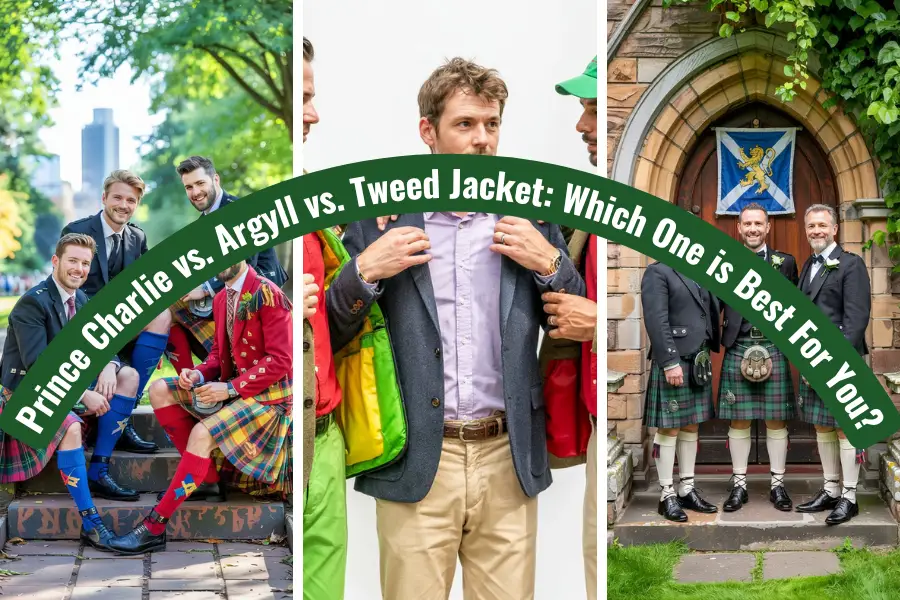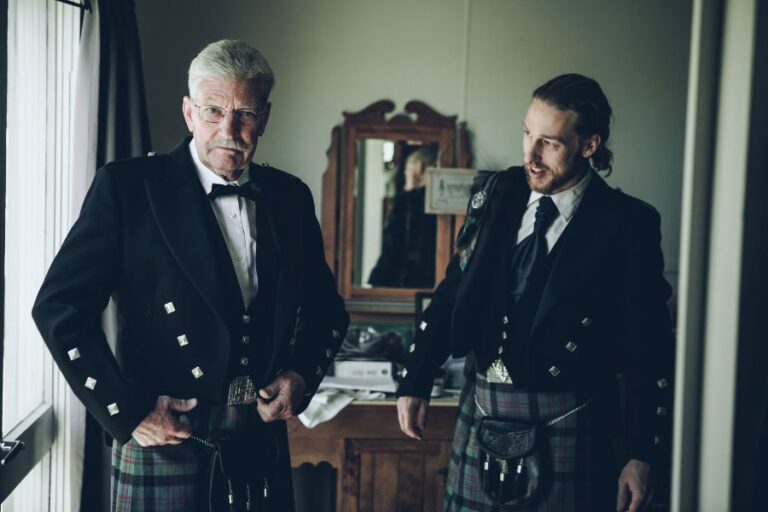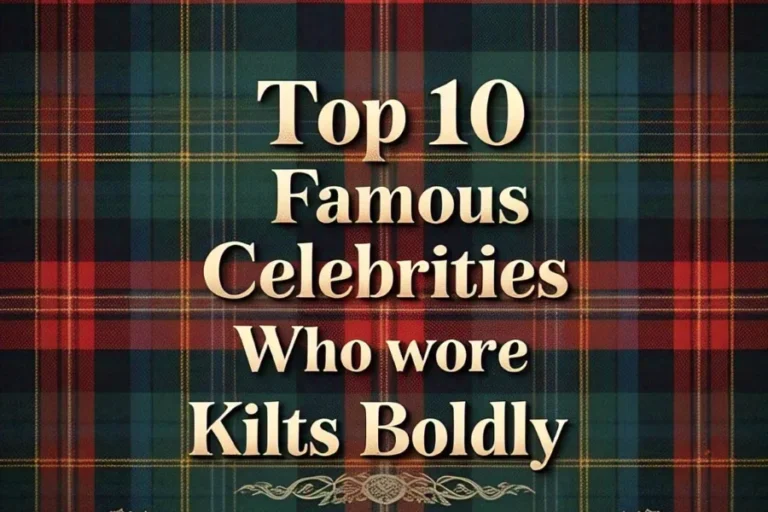Prince Charlie VS. Argyll VS. Tweed Jacket: Which One is Best For You?
Shopping for kilt jackets can get overwhelming. You think you’re just buying something to go with your kilt, and then suddenly there are dozens of styles, names you can’t pronounce, and traditions you feel like you should know. Maybe you’ve seen the sharp silhouette of a Prince Charlie jacket, or the more relaxed fit of an Argyll jacket, or the textured charm of a Tweed kilt jacket—but which one is actually right for you?
Let’s break it down in a real, practical way. No fluff. No gatekeeping.
What Exactly Are Kilt Jackets?
Before comparing styles, let’s be clear about what we’re even talking about.
Kilt jackets are formal or semi-formal jackets designed to be worn with kilts. They’re cut shorter than standard suit jackets so they sit neatly above the pleats. Most include buttoned cuffs, high armholes, and a tailored look—because kilts already draw the eye, the jacket’s job is to complement without competing.
There are three main types you’ll come across:
Each has its own use, feel, and level of formality.
Prince Charlie Jacket – Formal and Traditional
You’ve probably seen this one at a wedding or on a guy playing bagpipes. The Prince Charlie jacket is the most formal of the lot. It’s meant for black-tie occasions—think weddings, evening events, or formal Highland dress balls (if that’s something you’re into).
It usually comes with:
- Satin lapels (like a tuxedo)
- Silver buttons on the front, sleeves, and tails
- A short, cropped back
- Paired with a 3-button or 5-button waistcoat (vest)
It’s sharp. Regal even. You feel dressed up the moment you put it on.
But… is it versatile? Not really. This is not your everyday jacket. If you’re heading to a pub or a daytime event, you’ll probably feel out of place.
Pros:
- Looks high-end and formal
- Great for weddings and black-tie events
- Makes a strong first impression
Cons:
- Not suitable for casual or even semi-formal wear
- Slightly restrictive styling—doesn’t leave room for personal flair
- Expensive, usually
Argyll Jacket – Semi-Formal and Adaptable
The Argyll jacket (or Argyle jacket) is your middle-ground option. It’s less formal than the Prince Charlie but still smart enough for most events. It’s got a more classic blazer feel, which means you can pair it with a wider range of shirts, waistcoats, and accessories.
Typically features:
- Short cut to match your kilt
- Regular lapels (not satin)
- Decorative buttons on the cuffs and front
- Usually worn with a 5-button waistcoat or even on its own
It’s perfect if you’re attending a wedding but not the groom—or if you just want something traditional without being over the top.
Personally? I like this one. It doesn’t scream for attention, but it doesn’t blend in either.
Pros:
- Works for most occasions—day or night
- Easier to dress up or down
- More comfortable and relaxed than a Prince Charlie
Cons:
- Doesn’t have the grandeur of the Prince Charlie
- Can feel too “in-between” for some—neither casual nor ultra-formal
Tweed Kilt Jacket – Casual and Outdoorsy
This one’s for the texture lovers. The tweed kilt jacket is made from pure wool, often in earth tones or subtle checks. It gives off a rustic, grounded vibe. Picture something you’d wear to a country wedding, Highland Games, or even just a weekend gathering.
Key details:
- Heavier fabric, often Harris Tweed or similar
- Natural tones like olive, brown, grey, or navy
- Typically worn with a matching or contrasting waistcoat
- Looks best in daylight or outdoor events
It’s not trying to impress the Queen. But it does say you know what you’re doing—and you’re not trying too hard.
I’ve heard people say it’s the most “wearable” of the bunch, and that makes sense. It pairs well with casual shirts, boots, even a tie if needed. If you’re someone who wants a Scottish kilt jacket that you can actually wear more than once a year, this might be the one.
Pros:
- Very comfortable and practical
- Ideal for daytime or outdoor wear
- Has personality without being flashy
Cons:
- Not suited for formal events
- Less structured than Prince Charlie or Argyll
How To Choose The Right Kilt Jacket
So… which one’s best for you? It really depends on:
- How often you’ll wear it
- Where you’ll wear it
- What kind of style feels right to you
Choose Prince Charlie if:
- You’re attending formal black-tie events
- You like traditional Highland dress
- You want to go all-in for a special occasion
Choose Argyll if:
- You want something semi-formal that works for weddings, dinners, or ceilidhs
- You like a classic, tailored look
- You’re buying your first kilt jacket and want something safe
Choose Tweed if:
- You prefer comfort and texture over shine
- You go to daytime events, Highland games, or casual gatherings
- You want a jacket you can wear in multiple settings
A Quick Word on Accessories
Whichever jacket you go with, keep in mind the rest of the outfit matters just as much. A Prince Charlie jacket usually means:
- Lace-up brogues
- Wing collar shirt
- Ruched or bow tie
An Argyll jacket or Tweed jacket? You’ve got more freedom. Even a plain dress shirt and boots can work if styled right.
And waistcoats? Not essential, but they complete the look. Especially for Argyll and Tweed styles.
Final Thoughts
There’s no single “best” mens kilt jacket. That’s the truth.
Some guys buy all three over time. Some stick with one versatile style and make it work for everything. It depends on how often you wear your kilt—and honestly, how you feel wearing different jackets.
If you’re shopping through kilt jackets for sale, don’t just focus on tradition. Think about you—your events, your style, your comfort. That’s what’ll make you look and feel right in the end.
Sure, you could go with the Prince Charlie and feel like you’re in a royal procession. Or you could choose the Argyll and blend tradition with practicality. Or—if you ask me—the Tweed jacket might just be the hidden gem. It’s low-key, textured, earthy… kind of like Scotland itself.
No need to rush it. Try them on if you can. Or at least look at plenty of photos. Imagine where you’d wear it, what you’d pair it with, and whether you’d feel overdressed or right at home.
And remember: a good Scottish kilt jacket isn’t just about looking sharp. It’s about feeling connected—to heritage, to place, to something slightly bigger than yourself.
Just don’t forget the jacket’s job: to serve the kilt. Not to steal the show.












